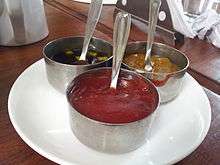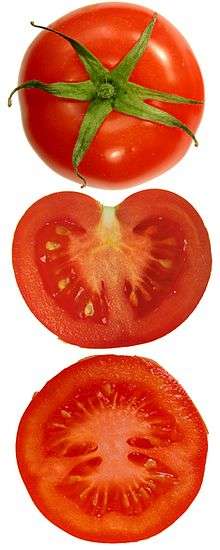Condiment
A condiment is a spice, sauce, or preparation that is added to food, typically after cooking, to impart a specific flavor, to enhance the flavor,[1] or to complement the dish. A table condiment or table sauce is more specifically a condiment that is served separately from the food and is added to taste by the diner.
Condiments are sometimes added prior to serving, for example, in a sandwich made with ketchup, mustard or mayonnaise. Some condiments are used during cooking to add flavor or texture: barbecue sauce, compound butter, teriyaki sauce, soy sauce, and marmite and sour cream are examples.
Many condiments, such as mustard or ketchup, are available in single-serving packets, commonly when supplied with take-out or fast-food meals.
Definition


The exact definition of a condiment varies. Some definitions encompass spices and herbs, including salt and pepper,[2] using the term interchangeably with seasoning.[3] Others restrict the definition to include only "prepared food compound[s], containing one or more spices", which are added to food after the cooking process, such as mustard, ketchup or mint sauce.[3] Cheese is also considered a condiment in some European countries.
Etymology
The term condiment comes from the Latin condimentum, meaning "spice, seasoning, sauce" and from the Latin condire, meaning "preserve, pickle, season".[4] The term originally described pickled or preserved foods, but its meaning has changed over time.[5]
History
Condiments were known in Ancient Rome, Ancient India, Ancient Greece and Ancient China. There is a myth that before food preservation techniques were widespread, pungent spices and condiments were used to make the food more palatable,[6] but this claim is not supported by any evidence or historical record.[7] The Romans made the condiments garum and liquamen by crushing the innards of various fish and then ferment it in salt, resulting in a liquid containing glutamic acid, suitable for enhancing the flavor of food. This process would lead to a flourishing condiment industry.[4] Apicius, a cookbook based on fourth and fifth century cuisine, contains a section based solely on condiments.[4]
List of condiments
Condiment market in the United States
In the United States, the market for condiments was US$5.6 billion in 2010 and is estimated to grow to US$7 billion by 2015.[8] The condiment market is the second largest in specialty foods behind that of cheese.[8]
Gallery
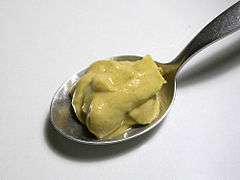
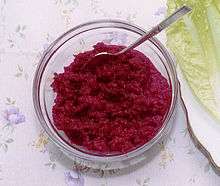 Chrain (horseradish sauce)
Chrain (horseradish sauce) Tomato Ketchup
Tomato Ketchup
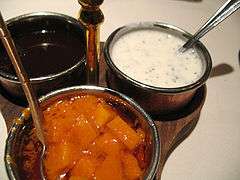
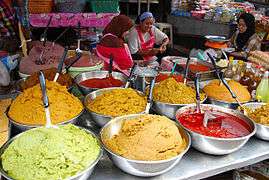 Curry powder or paste
Curry powder or paste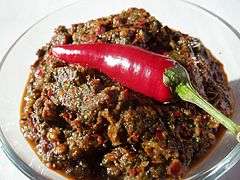 Ajika, spicy sauce in Caucasian cuisine
Ajika, spicy sauce in Caucasian cuisine
 Packets of duck sauce
Packets of duck sauce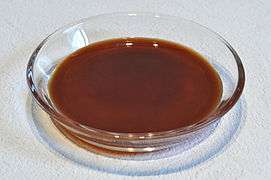

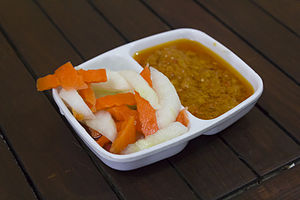
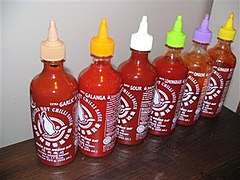 Sriracha (type of Hot sauce)
Sriracha (type of Hot sauce)
See also
- Condiments by country (category)
- Dip
- Garnish
- List of fish sauces – Wikipedia list article
- List of foods
- List of mustard brands – Wikipedia list article
- Non-brewed condiment
- Seasoning
- Spice – Vegetable substance other than leaves primarily used for flavoring, coloring or preserving food
- Relish – A cooked, pickled, or chopped vegetable or fruit food item typically used as a condiment
- Ingredient
References
Citations
- Merriam-Webster: Definition of condiment
- Collins: Definition Condiment
- Farrell, p. 291
- Nealon
- Smith, pp. 144–146
- Farrell, p. 297
- According to Paul Freedman, the idea is presented as a fact even by some modern scholars, despite the lack of any credible support; Freedman (2008), pp. 3–4
- Sax, David (October 7, 2010). "Spreading the Love". Bloomberg Businessweek. Retrieved 9 October 2010.
Sources
- "Collins: Definition Condiment". Collins Dictionary. n.d. Retrieved 29 September 2014.
- Farrell, K. T. (1990). Spices, Condiments and Seasonings (2nd ed.). MA, USA: Aspen Publishers. p. 291. ISBN 9780834213371.
- "Merriam-Webster: Definition of condiment". Merriam-Webster Dictionary. Retrieved October 23, 2011.
- Nealon, Tom (7 September 2010). "De Condimentis". HiLobrow. Retrieved 10 February 2014.
- Smith, Andrew F. (May 1, 2007). The Oxford companion to American food and drink. Oxford University Press. ISBN 978-0-19-530796-2. Retrieved March 15, 2012.

